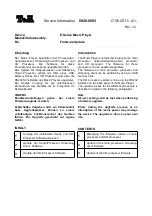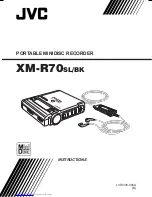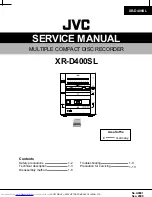
MULTITRACK RECORDING TECHNIQUES
n
ONE EXAMPLE OF A MULTlTRACK
RECORDING PROCESS
Multitrack recording is usually used to record a rhythm
section, with overdubbing and ping-ponging operations
assisting in mixing the parts of the various musicians in
the proper balance. Finally, the tape is mixed down to
produce a stereo master tape.
These are the steps in our example:
Record the drums on track 1
Record the bass on track 2
Record the rhythm guitar on track 3
Ping-ponging tracks 1 –- 3 onto track 4
(freeing tracks 1 – 3)
Record the keyboards on track 3
Record the lead guitar on track 2
Record the vocals on track 1
Mixdown tracks 1 – 4 to produce a stereo
master tape
Track 1
T r a c k 2
T r a c k 3
T r a c k 4
M i x d o w n
n
BEFORE RECORDING
RECORDING LEVEL
In making a good recording, the most important step is
setting the ideal recording level. If the level is too low,
the recording will contain a lot of noise and hiss; if the
level is too high, the recording will sound distorted and
unclear. The MT2X is equipped with peak level meters
which show the level of each track, as well as the level
of the stereo output signal. Use these meters to help you
set the ideal recording level. If the level meters “peak
out” (show the maximum reading) briefly, it’s not a pro-
blem. However, if they’re peaking out for more than a
second or two, then distortion may become a problem.
dbx SYSTEM
Keep the dbx switch “ON” to expand dynamic range and
to reduce inherent tape noise.
SELECT THE BEST TAPE SPEED
The MT2X gives you a choice of two tape speeds. The
low speed gives you about double the record/playback
time of the high-speed mode — at the expense of
reproduction quality. Use the low-speed mode when
making test recordings or simply trying out ideas. Use
the high-speed mode when you need the best possible
sound quality — when recording an important demo, for
example.
PLAN CAREFULLY FOR MICROPHONE RECORDING
Since the MT2X only permits microphone recording via
channels 1 and 2, one or both of these channels must
be kept available if you plan to record with microphones.
STEREO POSITIONING
It’s important to think about the acoustic “position” of
all the instruments well before you start your multitrack
recording.
Here’s one example of acoustic positioning. Set the bass
drum and the snare drum in the center, with the tom-
toms and high hat set off to either side to bring out the
“stereo” effect. The bass and other “heavy” instruments
should be in the center, with the keyboards to the left
and the guitar to the right. Solo instruments and voices
should span both right and left. Solo instruments with
a stereo output can have their left channel connected
to a delay machine, while the right channel is recorded
directly. You can probably think of many other different
ways to “arrange” the soundstage.
EQUALIZATION AND EFFECT PROCESSING
Equalization and effect processing are usually added at
the ping-pong and mixdown stages. In multitrack record-
ing, these types of signal processing can be decided on
later, and employed to any degree necessary. However,
the MT2X is limited in the number of effects which can
be used during mixdown, so it’s best to use them dur-
ing the initial recording stages.
MONlTORlNG
In addition to circuits for signal recording, this unit also
features a separate monitor circuit to allow the performer
to monitor the levels of the recording in progress through
a pair of headphones. In this case, set the PHONES
SELECT switch to the “MONITOR” position. Adjust the
volume level of each track with its MONITOR LEVEL
controls.
In addition, powered monitor speakers can be directly
connected to the ST OUT jacks or the AUX SEND jack.
16
















































